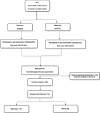The prevalence and risk factors for cataract in rural and urban India
- PMID: 30900578
- PMCID: PMC6446631
- DOI: 10.4103/ijo.IJO_1127_17
The prevalence and risk factors for cataract in rural and urban India
Abstract
Purpose: To report the prevalence and risk factors of cataract and its subtypes in older age group.
Methods: A total of 6617 subjects were recruited from both rural and urban areas. A detailed history including data on demographic, socioeconomic and ocular history was obtained. Lens opacity was graded according to the Lens Opacity Classification System III (LOCS III).
Results: Cataract was present in 1094 of the rural and 649 subjects in the urban population. Monotype subtype cataracts were found in 32% and 25% in rural and urban population and 12.68% and 18.6% were mixed cataracts in the rural and urban groups. In baseline characteristics history of diabetes, alcohol intake and presence of age-related macular degeneration were the risk factors in urban group. On multivariate analysis, the only significant risk factors for any cataract in subjects ≥60 years were increasing age in both rural [odds ratio (OR), 1.07] and urban (OR, 1.08) population, and HbA1c (OR, 1.14) in rural population. Overweight (OR, 0.6) was found to be a protective factor, and lower social economic status (OR, 1.52) a risk factor for cataract in urban population. A significant urban-rural difference was found in the prevalence of cataract and its subtypes (P ≤ 0.05).
Conclusion: We found the risk factors for any cataract in older age group to be increasing age and HbA1c in rural group. Age and lower social economic status were found to be the risk factors in urban arm. A statistically significant difference was found on comparison of the prevalence of cataract and its subtypes between the rural and urban population.
Keywords: Prevalence of cataract; risk factors; rural–urban.
Conflict of interest statement
None
Figures
References
-
- Rao GN, Khanna R, Payal A. The global burden of cataract. Curr Opin Ophthalmol. 2011;22:4–9. - PubMed
-
- Liu YC, Wilkins M, Kim T, Malyugin B, Mehta JS. Cataracts. Lancet. 2017;390:600–12. - PubMed
-
- Mohan M. Survey of blindness-India (1986–1989). In: Summary Results: Programme for the Control of Blindness. Ministry of Health and Family Welfare, Government of India: New Delhi. 1992
-
- Dandona L, Dandona R, Srinivas M Giridhar P, Vilas K, Prasad MN, et al. Blindness in the Indian state of Andhra Pradesh. Invest Ophthalmol Vis Sci. 2001;42:908–16. - PubMed
Publication types
MeSH terms
LinkOut - more resources
Full Text Sources
Medical


